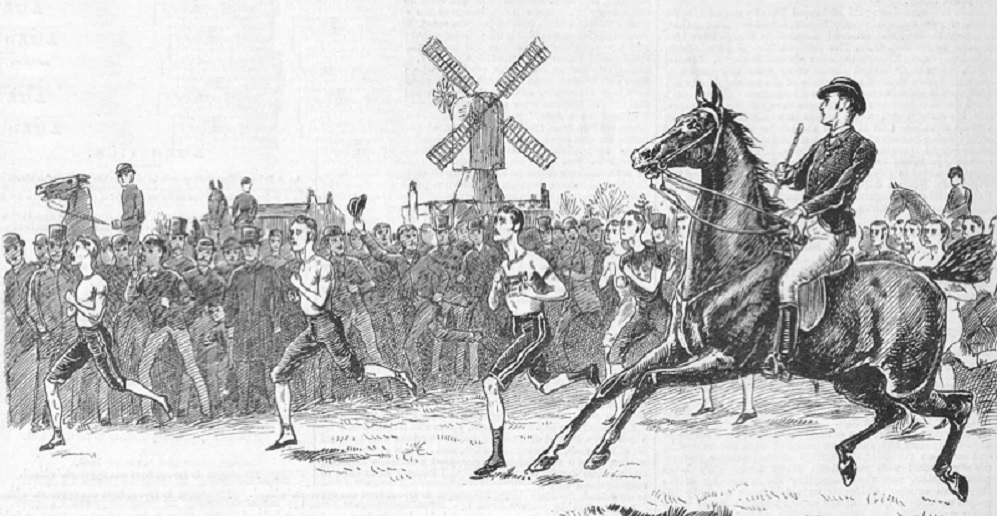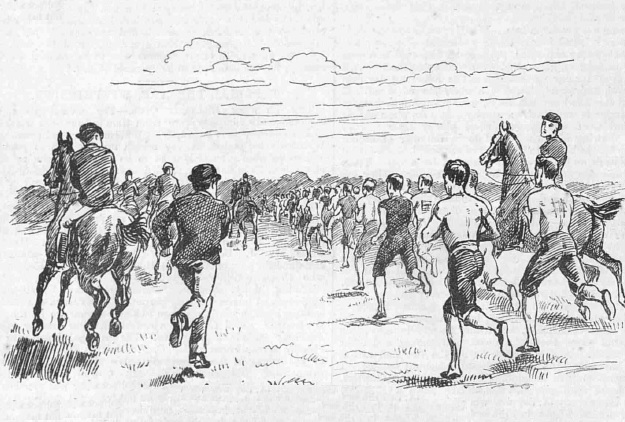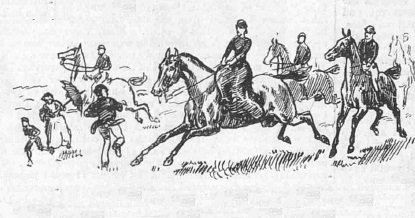Wimbledon Common, Roehampton on Saturday 03/03/1883 (Senior Men)

THE CROSS-COUNTRY CHAMPIONSHIP
In beautiful weather this important event, which may be justly termed the blue riband of cross-country athletics, was decided last Saturday afternoon, over the usual course, commencing at Roehampton. The clubs competing were three less than was the case last year, when eleven organisations were represented, and of those the Isledon and Camp Hill (Birmingham) Harriers, and the West London and Bristol and Clifton Athletic Clubs did not take part last Saturday, whilst the Thames Hare and Hounds, though entered on the present occasion, did not start a team, those who had never taken part previous to this year being the Ranelagh Harriers and the London Midland A.C. As was the case twelve months ago, the contest was deemed to lie entirely between the two powerful Birmingham clubs, the Moseley and Birchfield Harriers, and despite of the defeat of the former the last-named in the race of the Midland Counties Championship on the 3rd ult., the Moseley were the favourites, though the friends of the Birchfields felt confident that their men would able maintain the prestige gained by their sensational victory at Sutton Coldfield, but, as was the case last year, the Moseley spared pains to get as fit as possible, and not only turned the tables on their Midland conquerors in a most decisive manner, but would also have been returned victorious if the whole of the remaining clubs competing had been combined against them, as less than seven out of the first ten men in were bearers of the Moseley gate, and their defeat on February 3 appears inexplicable on the face of this.

Crossing Wimbledon Common
The Birchfield came next, but three members of this team who were expected to finish with the leading division - Thornton (second in the Midland Championship) - Stagg, and Savage, failed to show up prominently, and may not have liked the extra distance. T. Lawrence, again, ran in most consistent manner, and, though heavily backed at home for first place, only finished fourth. Soon after start the first quintette, in separating from the remainder of the field, fought out the contest from end to end, and little Dunning, who looked as fit as hands could make him, is to be congratulated on achieving his second victory in this competition, having been victorious in 1881, when he beat W. Snook, Moseley H., to six inches, after a desperate finish. Dunning, but for the poor show made in the South London Harriers' Steeple Chase the previous Saturday, when he was decisively beaten by both George and Foreman, would have been a much greater favourite, and we are given understand that the little 'Beagle' was indisposed on that occasion. George, who looked very big, was greatly fancied - indeed, it was almost impossible to get offer of any kind against him - but, as the result proved, was hardly in the condition necessary for so arduous a struggle, and failed when the pinch came; but, though defeated, he deserves a word of praise for determination with which he stuck to his work, and gained the second place. Foreman, the third man in, headed the Londoners, and showed greatly improved form to that he has hitherto displayed. Whatever induced the London Midland send a team is best known to themselves, as they had but two men - the forty-ninth and fifty-third - in the first sixty; but the Ranelagh youngsters ran better than was expected.
The going was first-class, and it was confidently expected that the record made by P. H. Stenning in 1878 (1 hour 6 min. 40 sec.) would be beaten; and such, indeed, proved to be the case, as both Dunning and George got home inside this time. The arrangements were all that could be desired, with the exception of the finish, and the spectators rushing in as soon as Dunning had passed, seriously impeding both the second and third men; indeed, George thinks that but for this he would have been able to get up, but in this opinion we do not coincide, and there is no doubt but that Dunning won on his merits, and it is worthy of remark that twice during the race the latter lost some little distance through going wrong. As no paper can laid across Wimbledon Common, the competitors were piloted by equestrians, who assembled in such numbers that it is a wonder the leaders were not ridden down by some, whose conduct more resembled that of 'tailors' than gentlemen. Soon after the advertised time, four p.m., the men were duly marshalled their respective positions the starting point, and Mr. James Gibb sent them on their journey.
Snook was the first to show in front, but on reaching Wimbledon, Dunning was a yard or so in front of George, Snook being third, and T. Lawrence fourth, about ten yards in front of Foreman. A considerable gap occurred, then came Hickman, Carter, Thornton, and Alexander. The tail here was quite a quarter of a mile long, the absolute last man being Hughes, of the London Midland. Soon after this Dunning lost some distance by overrunning the trail, and at Merton, George was just in front of the last-named, whilst Foreman, Snook, and T. Lawrence were close up. At West Barnes crossing the above quintette were nearly 150 yards in front the remainder of the field, which was headed by Carter, Bannister, Haydon, Crellin, Lidiard, and Crowther, in the order named.

Following the runners - rather dangerous for foot passengers
Reaching Christ Church, T. Lawrence was leading, but there was little to choose between the first five, of whom George and Snook were apparently in difficulties. Reaching the Common, Foreman, running very strongly, took first place, and the pace increased, T. Lawrence and Snook falling hack. race was now confined to Foreman, George, and Dunning, and rather more than a mile from home the latter spurted, and quickly rushed past his men. George struggled the gamest possible manner, and though he gained a bit at last, he failed to get up, and being compelled to ease at the finish, was defeated by twenty yards, after a most plucky race. Foreman, who was also interfered with, was rather more in the rear; then at frequent intervals came T. Lawrence, Snook, Carter, and Hickman in the order named. After the numbers (the scoring being by points, according to the places in which the men finished that with the least number to win) had been counted, it was found that the Moseley had won easily, the Birchfield being second, and the South London third.